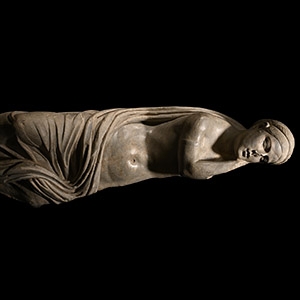Home > Auctions > 3 - 8 September 2024
Ancient Art, Antiquities, Natural History & Coins
Auction Highlights:
From a military inspired collection formed from the 1990s.
Accompanied by an academic paper by military specialist Dr Raffaele D'Amato, dated 15 July 2019 and titled 'Eastern Roman Empire - Greek Fire Bomb or Hand Grenade (μεσαίον kακάβιον) 9th-11th century AD'.
Cf. Arendt, W. I., Granaten des 13-14. Jahrhunderts, die an der Wolga gefunden sind, Zeitschrift fur Historische Waffen-und Kostumkunde, 11 (1926-8), p.42; cf. Arendt, W., Die Spharisch-konischen Gefäße aus Gebranntem Ton, ibid; cf. Ayalon, D., Gunpowder and Firearms in the Mamluk Kingdom, London, 1956, p.16.
Apart from the use of siphons or manual flame-throwers called cheirosiphona, special corps of Roman soldiers employed terracotta grenades, in the form of small jars, abundantly evidenced in archaeological excavations. They were called μεσαία kακαβιά or κυτροκακάβια where the former had a bulbous shape and the latter a more cylindrical form.
Ex London collection, formed 1990-2000.
See Muscarella, O.W., Bronze and Iron Ancient Near Eastern Artifacts in the Metropolitan Museum of Art, New York, 1988, pp.289ff, for similar arrowheads.
Although some of them are different in shape, these arrowheads are apparently related types of a polythetic group. Two basic deltoid forms are represented: one has a sharp, flat blade, the ends of which extend to form wings or barbs, and a prominent midrib extending into a long tang that often has a stop; the blade shape varies from deltoid to more manifestly triangular. The other form has no barbs, but it has a prominent midrib extending to the tang, and a narrow leaf-shaped blade.
From a collection acquired on the UK art market from various auction houses and collections mostly before 2000.
From an important Cambridgeshire estate; thence by descent.
From the collection of the famous author, writer and speaker, Gordon Bailey, Essex, UK; formed since 1968.
Private collection, Arundel, West Sussex, UK, 1975-late 1990s.
Cf. Milovanic, D., Metalwork in Serbia (in Serbian), Belgrade, 1986, fig.342, for similar specimen.
From the collection of the famous author, writer and speaker, Gordon Bailey, Essex, UK; formed since 1968.
Cf. Bailey, G., Detector finds 5, Witham, 2002, fig.7, p.31, for the 14th century snaffle bit; fig.5a-b-c, p.39, for the 15th-16th iron stirrup.
Snaffle bits have not altered very much in their design over the centuries. Medieval snaffle bits have survived in reasonable numbers, although they are still rare. A number of different designs are known for them. Some had a plain straight bar serving as the mouth piece, like our example. The 15th-16th century stirrup shows an interesting decoration at the sides of the footrest.
Ex private North American collection, California, USA, 1970s-1990s.
Acquired 1990s-early 2000s.
East Anglian private collection.
On original Pseudo-Corinthian or Apulo-Corinthian helmets see Bottini, A., ‘Apulo-Korintische Helme’, in Bottini, A., Egg, M., Von Hase, F. W., Pflug, H., Schaaf, U., Schauer, P., Waurick, G., Antike Helme, Sammlung Lipperheide und andere Bestände des Antikenmuseums Berlin, Mainz, 1988, pp.107-136.
The helmet is modelled upon the pseudo-Corinthian models of antiquity. The gryphon represented refers to the wars between these mythological creatures and the Arimaspes.
From the collection of the famous author, writer and speaker, Gordon Bailey, Essex, UK; formed since 1968.
From a specialist collection of militaria, London, UK, collected 1990s onwards.
Accompanied by an academic paper by military specialist Dr Raffaele D'Amato, dated 15 July 2019 and titled 'Eastern Roman Empire - Greek Fire Bomb or Hand Grenade (μεσαίον kακάβιον) 9th-11th century AD'.
Cf. Arendt, W. I., Granaten des 13-14. Jahrhunderts, die an der Wolga gefunden sind, Zeitschrift fur Historische Waffen-und Kostumkunde, 11 (1926-8), p.42; cf. Arendt, W., Die Spharisch-konischen Gefäße aus Gebranntem Ton, ibid; cf. Ayalon, D., Gunpowder and Firearms in the Mamluk Kingdom, London, 1956, p.16.
Apart from the use of siphons or manual flame-throwers called cheirosiphona, special corps of Roman soldiers employed terracotta grenades, in the form of small jars, abundantly evidenced in archaeological excavations. They were called μεσαία kακαβιά or κυτροκακάβια where the former had a bulbous shape and the latter a more cylindrical form.
Acquired in Germany in 2000.
Acquired by the present owner from the above.
Cf. Ehrenberg, M., Bronze Spearheads from Berks, Bucks and Oxon, BAR 34, Oxford, 1977, tables 21, 22, for type.
UK private collection before 2000.
Acquired on the UK art market.
Property of a London gentleman.
Cf. Gorelik, M., Weapons of Ancient East, IV millennium BC-IV century BC, Saint Petersburg, 2003, in Russian, for similar arrowheads from Eurasian sites (plate XLIV, nos.19,31,32,36,37,38,39,51,71).
In Greek warfare archery was mainly employed by Scythians and Cretans for the longer-ranks. Both used composite bows made of wood, horn, bone and sinew. This explains the great range of Scythian arrowheads found on the Greek sites.
1129 - 1140 of 3369 LOTS

.jpg)

.jpg)
.jpg)

.jpg)
.jpg)

.jpg)






.jpg)







